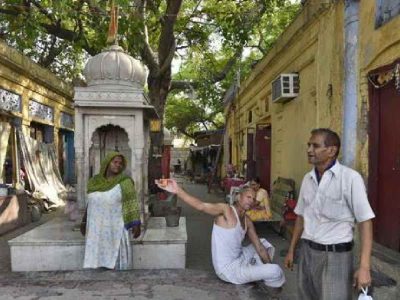As the world prepares to celebrate International Women’s Day on March 8, an evocative art exhibition in New Delhi is set to explore the intricate layers of femininity, tradition, and modernity in urban India. Franco-Indian artist Olympe Ramakrishna brings her striking installation Women of Urban India to the Alliance Française de Delhi, presenting a series of twelve deeply detailed portraits printed on silk and suspended in the gallery like saris drying on rooftop terraces. The exhibition will run from March 8 to 18.
A fusion of European artistic traditions and Indian cultural aesthetics, Ramakrishna’s work offers a compelling glimpse into the lives of middle-class, urban Indian women. Previously showcased in Bangalore, Pondicherry, Ahmedabad, and France, this much-anticipated Delhi debut promises an immersive visual experience that transcends artistic boundaries.
Also read: Dilli-6 and Zaiqa-e-Dilli offers a slice of Old Delhi for sophisticated palates
Strength and sensuality
At the heart of Women of Urban India is a series of oil-painted portraits transferred onto dupion silk, a fabric that embodies both sensuality and heritage. The artist’s eleven muses—Lux, Roopashree, Romi, Shushika, Charisma, Kavitha, Chandu, Arpitha, Sneha, Hitha, and Deepti—are women from her per sonal circle, captured in moments of power, grace, and quiet rebellion. The twelfth portrait is a self-portrait, embedding Ramakrishna herself into the collective story she tells through her art.
“I’m not trying to portray extraordinary figures but rather to capture the everyday lives of the women around me,” says Ramakrishna. “Each portrait tells a unique story, yet together they explore broader themes such as emancipation in a rapidly changing society while remaining rooted in cultural heritage.”
One of the most striking portraits in the exhibition is that of Sneha, a lawyer, depicted with the regal bearing of a historical ruler. Inspired by French painter Bernard Boutet de Monvel’s celebrated portrait of Maharaja Yashwant Rao Holkar of Indore, Sneha is draped in traditional Maratha attire, complete with an ornate turban and exquisite jewellery. The composition exudes authority, symbolising women’s increasing presence in professions once dominated by men.
Confluence of East and West
Born in Normandy, France, Olympe Ramakrishna spent nearly a decade honing her craft at prestigious institutions such as Beaux-Arts in Paris and the Battersea Art Centre in London. Influenced by European masters like Jean-Auguste Dominique Ingres, Henri Rousseau, and Paul Gauguin, she later discovered a new visual language in India’s rich artistic traditions— Mughal miniatures, Company paintings, and the evocative story telling of Raja Ravi Varma and Amrita Sher-Gil.
“My artistic practice is deeply shaped by both worlds,” she told Patriot. “From the West, I draw inspiration from academic portraiture traditions and luminous real ism. India, on the other hand, transformed my approach to colour, leading me to embrace warmer palettes and a more symbolic treatment of form. The intricate details of miniature paintings and the narrative richness of Company paintings have also influenced my work.”
A unique gallery experience
Visitors to the exhibition will find themselves surrounded by floating portraits, suspended from wires that allow them to shift subtly with the ambient air. This creates an ethereal presence, evoking the familiar sight of saris billowing on terraces across Indian cities.
“The exhibition design allows these women to float around the gallery, their presence both ground ed and soaring,” says curator Shankar Tripathi. “This spatial arrangement imbues the viewing experience with atmosphere and movement, making the portraits feel alive.”
By blurring the lines between art and environment, Ramakrishna transforms the gallery into an inti mate space where viewers are encouraged to engage with each portrait from multiple perspectives—both physically and conceptually.
Feminine identity and power
Ramakrishna views Women of Urban India as both a personal reflection and a broader commentary on the evolving role of women in Indian society. “My dual cultural identity allows me to navigate between different perspectives on femininity and urban life in India,” she says.
“Women here move through layered expectations, shaping and reshaping their identities within both public and private spheres.”
This understanding is reflect ed in her choice of materials. “I photographed the original can vases, which I had painted in oil, and then digitally printed them on a large scale onto silk panels, reminiscent of the fabric of saris,” she explains. “The sari, a symbol of both sensuality and tradition, evokes a familiar scene from Indian streets, where vibrant saris are draped over metal wires on rooftop terraces to dry.”
Suspended on wires, the portraits shift with the ambient air, lending them a sense of fluidity and presence. This technique required overcoming significant technical challenges. “Finding the right textile was a long and demanding process: I tested various types of silk, each reacting differently to the ink, before identifying the one that provided the ideal result,” she shares.
Also read: Delhi: A Valentine’s escape to National Rose Garden
A vision beyond borders
For Ramakrishna, Women of Urban India is more than an exhibition—it is an evolving conversation. “I want viewers to feel a strong sense of presence—these women asserting their space, unapologetically,” she says. “More than anything, I hope people see their strength, their complexity, and their beauty, recognising them as individuals with layered identities.”
As the exhibition continues its journey to new cities in 2025, Ramakrishna is already exploring her next project: a large-scale textile piece combining painting and embroidery to tell the story of a forgotten woman from history. “The stories of women overlooked by history resonate deeply with me,” she says.
As India’s urban landscape continues to evolve, so too do the narratives of the women who shape it. Through her art, Olympe Ramakrishna captures their essence, ensuring their stories— like the silk that carries them— remain suspended in time, floating yet unforgettable.





